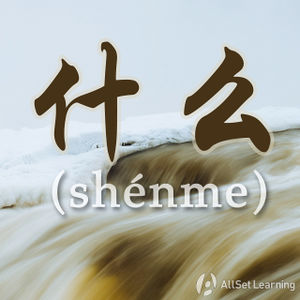Difference between revisions of "Expressing "everything" with "shenme dou""
(→Books) |
|||
| Line 91: | Line 91: | ||
=== Books === | === Books === | ||
| − | + | {{Source|Common Chinese Patterns 330 (汉语常用格式330例) |195}} | |
| − | + | {{Source|Modern Mandarin Chinese Grammar: A Practical Guide|286-8}} | |
| − | + | {{Source|Integrated Chinese: Level 1, Part 2 (3rd ed)|216-7}} | |
| − | + | {{Source|40 Lessons for Basic Chinese Course (基础汉语40课下册)|314}} | |
[[Category:A2 grammar points]] | [[Category:A2 grammar points]] | ||
Revision as of 07:09, 24 October 2017
-
Level
-
Similar to
-
Used for
-
Keywords
什么……都 (shénme... dōu) is a pattern often used to express "all" or "everything." Because it's not just one word, though, it can be a little tricky to get the hang of at first.
Contents
Basic Usage
Structure
In this structure, 都 (dōu) is more frequently used than 也 (yě)。
Topic (+ Subj.) + 什么 + 都 / 也 + Verb / Adj.
In some sentences, there will be a subject after the topic in the pattern above. See the following sentences for examples.
Examples
When used in the positive sense, it is more natural to follow 什么 (shénme) with 都 (dōu) rather than 也 (yě) to express "everything."
- 我 觉得 这里 的 菜 什么 都 好吃。I think everything is delicious here.
- 中国 的 历史 爸爸 什么 都 知道。My dad knows everything about Chinese history.
- 工作 的 事情 老公 什么 都 跟 我 说。My husband tells me everything about work stuff.
- 妈妈 做 的 菜 我 什么 都 喜欢。I like everything that mom cooks.
- 我女朋友 觉得 外国 的 东西 什么 都 好。My girlfriend thinks that all foreign things are good.
Structure with a Noun
Structure
什么 + Noun + 都 + Verb
Examples
- 我们 什么 果汁 都 喝。We drink any kind of fruit juice.
- 她 什么 衣服 都 是 黑色 的。All of her clothes are black.
- 妈妈 做 的 什么 菜 都 好吃。All of the dishes mom makes are tasty.
- 我男朋友 什么 运动 都 喜欢。My boyfriend likes all kinds of sports.
- 你 不 应该 什么 话 都 跟 他 说。You shouldn't tell him everything.
Negative Structure
Structures
The negative structure simply adds a 不 (bù) or a 没 (méi) after the 都 (dōu) / 也 (yě). Instead of "all" or "everything," this expresses "none" or "not any."
什么 + Noun + 都 / 也 + 不 + Verb
什么 + Noun + 都 / 也 + 没 (有) + Verb
Examples
- 生病 以后,爸爸 什么 酒 都 不 能 喝 了。After dad got sick, he can't drink any kind of alcohol.
- 老板 现在 很 生气,什么 人 也 不 见。 The boss is very angry. He's doesn't want to see anybody.
- 今天 我 不 舒服,什么 东西 都 没 吃。Today I don't feel well, so I didn't eat anything.
- 昨天 开会 的时候,她 什么 话 也 没 说。She didn't say anything at yesterday's meeting.
- 你 在 家里 怎么 什么 事 都 不 做?How come you haven't done anything at home?
See Also
Sources and further reading
Books
- Common Chinese Patterns 330 (汉语常用格式330例) (pp. 195) Anything Goes (无所不谈) →buy
- Modern Mandarin Chinese Grammar: A Practical Guide (pp. 286-8) Anything Goes (无所不谈) →buy
- Integrated Chinese: Level 1, Part 2 (3rd ed) (pp. 216-7) Anything Goes (无所不谈) →buy
- 40 Lessons for Basic Chinese Course (基础汉语40课下册) (pp. 314) [ →buy]



